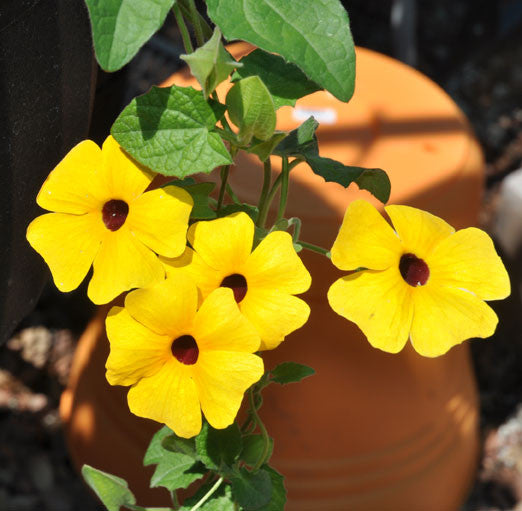Summer can be a real challenge for container gardening. It is common for container grown plants - particularly in the ubiquitous peat-based potting mixes - to struggle during the heat of July and August. Hanging baskets are vulnerable, with such open exposure to the elements, and patio planters can become a chore during prolonged heat and sun. Aside from the worry associated with keeping on top of watering, the plants themselves can quickly suffer if the fine root hairs found towards the edge of containers dry out. The good news: there are tons of easy ways to alleviate these stresses.
1) Grow in the largest containers that make sense for your space. The rule of thumb definitely holds that larger pots dry out less quickly, and resist heat stress better, than smaller containers. Of course there has to be a balance between what is practical, what is beautiful and what is best for reducing root stress - but avoid the temptations of super cute mini-pots (as often seen on Pinterest etc). The minimum size for herb pots is realistically at least 6" inches, and for veggies closer to 5 gallons.
2) Mulch the soil, even in containers. Mulches, which can be anything from shredded paper to shredded pallets (Enviro-Mulch) to old leaves, dramatically reduce water loss for both in-garden and container plants. Just avoid very heavy mulches that restrict air circulation.
Coir disks are available that fit easily around single stemmed plants in pot (e.g. around a Strawberry Guava or other tropical fruiting plant), providing a removable mulch solution that can be re-used for a few seasons. Mulching can reduce the need to water by up to 50%!
3) Compost, a gardener's best friend! Adding compost to your potting mix significantly improves the ability of the soil to hold water and slow release it out to the roots. Even top dressing with compost, similar to mulching, will be very helpful. Home compost can be added copiously to the soil for most types of container gardening. Commercial composts, such as Sea Soil, have much higher nitrogen content and are generally added at about 20% for fruiting veggies and flowering plants, up to 100% for foliage and tropical plants.
Coco Earth 4) Coco-earth. Aside from compost, the long fibres of shredded coconuts (called Coco-earth or coir) are truly great at helping the soil hold water then slow release it back out to the roots. Unlike the starch-based based "water gels", which get very messy during rains, the coir enhances the look and feel of the soil, and can reduce watering requirements by up to 50%. We generally add 20% coir for flowering baskets or pots, up to 40% for water lovers such as banana trees, and just 10% for drainage-loving herbs such as thyme or lavender.
5) Tuck plants into shade during heat waves. Even full sun varieties benefit from some shade during exceptionally hot weather, or if you know you are going to be away and unable to water for more than a few days.
6) Watering globe, DIY. A fool proof way to keep patio pots watered while away for a fews days (or just to reduce watering frequency) is the combination of a Plant Nanny watering spike and any recycled pop or wine bottle. The Plant Nanny is a simple, reusable device that connects snuggly with the recycled bottle to create a watering globe. Watering globes slow release water into the soil, only as the soil dries out... genius!
6) Apply Kelp. Dried north Atlantic kelp is one of the best resources organic gardeners can include in their gardening tool kit. Commonly sold as Sea Magic, this inexpensive, easy-to-use product can be applied to all types of plants (in the garden, in containers, on houseplants) and has many validated benefits. One of the important ways kelp extract helps plants is by reducing the effects of drought on the plant, allowing plants to go longer between waterings and also minimizing the effects of short term soil drought. Kelp can be applied by either watering into the soil or by spraying on to the leaves. Many gardeners include Sea Magic in their watering regime every 10 to 14 days.
7) Water deeply. It is better to water deeply but less frequently, as opposed to shallow watering more frequently. With each watering, be sure the potting mix is absorbing the moisture (soil that has dried out often repels water) and that water has made it through all levels of the soil and out the drainage holes. It is common to find plants stressed due to water only making its way part way through a container; once this happens a couple of times the bottom roots start to be damaged which is the beginning of the end for a once healthy potted plant. A strategy we use to avoid this is to water in two passes, a few minutes apart (ensures the water gets absorbed evenly and deeply).
Hope this offers up some easy ways to keep your plants drought-stress-free this summer... and keep you in love with your patio and hanging gardens!
7 simple strategies to avoid drought-stress in containers

1
-
I’ve just started making my own compost tea this season and am using many of the ingredients I’m reading about on your site. I’m coming there this afternoon to, hopefully, stock up,on some depletes ingredients.
I love the suggestions about watering and may make a purchase or two towards that end, GREAT article!!!
Barb Sutyla






